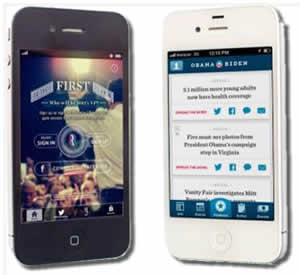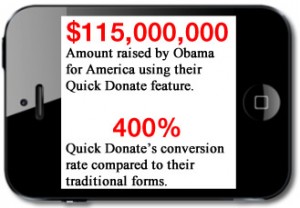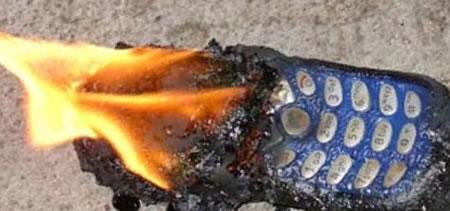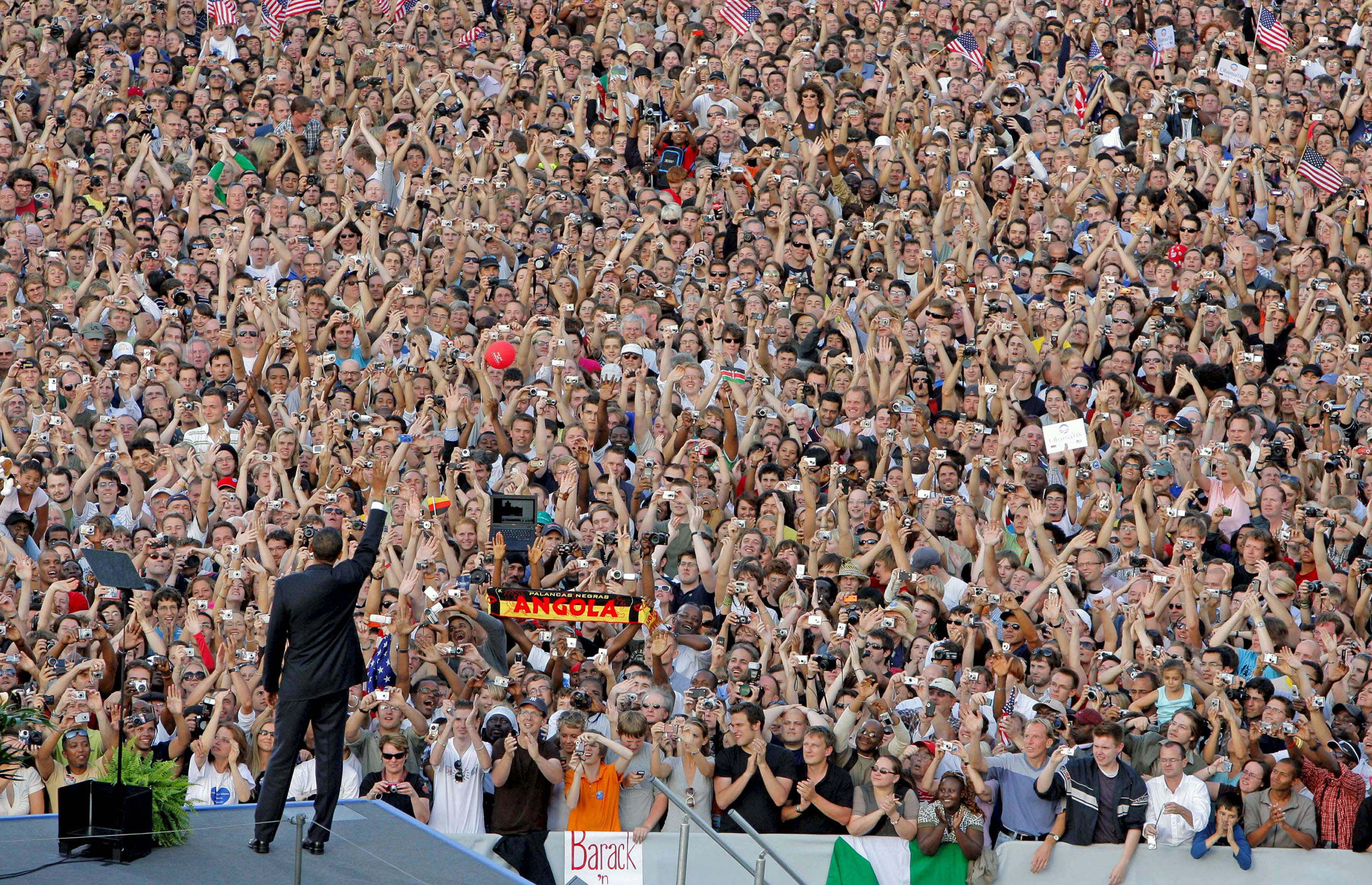Please Note: This is the third of a three-part series analyzing the full spectrum of mobile tools used by both presidential campaigns.
In Part 3, we will review how both campaigns leveraged mobile apps and text messaging..
Mobile Apps:
Like most of corporate America, both presidential campaigns became a little delusional with the potential of mobile apps. User retention trends tell a different story. According to research from Localytics, more than 40% of all mobile apps downloaded are use less than three times. If you’re lucky, your app is one of the 31% that’s open more than 11 times over a nine-month period.
Given the expense and time of developing mobile apps, their short shelf life and the promotional budget required to get them downloaded, these tools are not the answer for most campaigns (and companies for that matter). That said, both campaigns created their own and prove that point.
Romney did its best to update and Obama tactic from 2008. The campaign announced that it would be naming Romney’s running mate via a mobile app. That drove nearly 200,000 downloads in the first 48 hours. The campaign spent a sizable portion of their mobile advertising budget to drive further downloads. In the end, the media scooped the Paul Ryan choice, the campaign sent out an SMS first, and then the app pushed the announcement two days after it was old news. Following that debacle, future updates to the app were limited to social media integration, RSVPing for events and collecting donations – which was merely a link to a mobile webpage.
Obama’s mobile app fared better. Campaign actually released two apps: the first was little different than Romney’s attempt, but the second supported their field efforts. Users could register voters, join volunteer teams locally and even canvass their voters from the comfort of their own smart phone. The app was integrated with the campaign’s CRM and Google Maps to highlight potential voters within the volunteers’ area. With approval, it could even search through the user’s address book to find matches with their CRM. The field app was limited to smart phones and didn’t have a tablet implementation – a tragic mistake given the dramatic usage growth of tablets.
Mobile Messaging:
The popularity of SMS as mobile marketing tool certainly faded as others evolved. That said, text messaging still remain the most effective and cost-effective mobile marketing tool; just not the flashiest.
Unlike apps or mobile ads, 90% of mobile phones can accept SMS – a certain ubiquity. Text messaging volume continues to grow double digits year-over-year, especially with youth and voters of color who average over 50 text messages a day. And SMS open rates exceed 90%, which is nearly 10 times that of political e-mail messages.
Since its first use in 2008, SMS tools have advanced dramatically. Campaigns can now survey their supporters, set up peer-to-peer list building efforts and even engage in a one-to-one dialogues via SMS. Text messaging is the most effective way to get up-to-date information to supporters and send out GOTV reminders. Peer-reviewed research has shown that when used successfully, SMS reminders can increase the number of voters heading to the polls by 3 to 5% at costs that are less 10% that call banking.
Yet both campaigns fail to use mobile messaging effectively in 2012.
SMS didn’t even appear as a tool for the Romney campaign. Visitors to his websites had to dig into the fine print to find the opt-in information. Though their app offered an easy way for volunteers to opt-in, SMS subscribers across the country received little more than event updates and follow-ups e-mail campaigns.
In 2008, Obama built an SMS list of over 3 million, but let that list collect dust after his inauguration. His messaging innovations during his first election failed to follow to his reelection. Like Romney, Invitations to sign up for use SMS list were well hidden and never appeared in any political promotions either online, in print or in broadcast media, and SMS were used as reminders for prior e-mail campaigns.
Final Takeaways:
Both campaigns failed to use mobile apps and mobile messaging effectively, so here’s what we can learn:
- Most apps suck: While Obama’s field app had decent capabilities, the amount of time and effort that goes into developing a mobile app rarely provide adequate ROI for campaigns. Advocacy organizations could graduate to apps once they successfully use other mobile tools and understands their users’ needs.
- Don’t overlook SMS: While it might not be as flashy as other mobile tools, text messaging has ubiquity, advanced capabilities and is a must to any mobile marketing mix.
Please Note: This is the second of a three-part series analyzing the full spectrum of mobile tools used by both presidential campaigns.
In Part 2, we will review how both campaigns leveraged mobile advertising and fundraising.
Mobile Advertising:
Spending on mobile phone advertising is exploding. Industry spent more than $1.8 billion on mobile ads in 2011. A year later that number grew to $5 billion worldwide.
Like their desktop brethren, mobile advertising provides exceptional targeting capabilities. In 2012, Google’s AdWords platform allowed campaigns to even target by congressional district. Most platforms offered geo-fencing – which limits ads to a set radius, and geo-targeting by zip codes. Both campaigns took notice.
Obama used mobile video ads in Spanish to target Latino voters. His campaign placed ads on mobile games such as Scrabble, Tetris and many others. And smart use of mobile advertising helped the campaign reverse their funk after the first debate. We also found that fundraising tied to mobile advertising campaigns generate 60% more donations than their desktop equivalents.
Romney’s mobile advertising habits began at the Iowa Caucus and New Hampshire primaries. His campaign spent more on mobile ads appeared on Facebook, Apple’s iAD platform and Google’s AdMob. And they effectively leveraged it to boost app downloads and recruit volunteers using click-to-call to connect them with the nearest campaign office. Their biggest mistake though was that they did not increase their mobile budgets to maintain their lead coming out of the first debate.
Mobile Fundraising:
Money drives campaigns, and 2012 proved to be the most expensive presidential campaign ever: both campaigns raise a combined total of $2 billion. Mobile had a significant impact both campaigns fundraising efforts.
Obama raises over billion dollars ($726M directly) of which 55% came from small donors – those who gave less than $200 during the election cycle. One in ten of their online donations came from mobile. The campaign experimented with using Square for smartphone credit card processing and Text2Give for impulse donations with little success.

Their Quick Donate feature proved to be one of their most effective tools. Past donors who saved their credit card information and provided a mobile phone number received simple donation requests via SMS. The donor would simply have to reply the number, such as 50, and in the system would process a $50 donation from them. This tool was timed to key events to maximize the effect.
The Romney campaign was less successful in this realm. While they released over 5,000 Square readers at the national convention, the program results whenever released – a sure sign of a campaign disappointment. While the campaign raised $992 million ($467 million directly), less than 24% came from small donors. When users clicked donate on the Romney mobile app, they were routed to mobile site instead of processing the donation within the app.
Takeaways:
Since mobile advertising is often directly tied to fundraising, both campaigns provided us with a few lessons:
- Do your best to remove all barriers: Obama was Quick Donate feature did not require filling out a lengthy form on a smartphone to donate, and drove impulse donations.
- Technology without strategy typically fails: Both campaigns used Square and Text2Give without a full understanding of how best they could be applied, and their efforts proved disappointing.
- Mobile is scalable: After the first debates, Obama ramped up his mobile efforts when they proved effective and he needed it most while Romney maintained spending levels regardless of whether he was ahead or behind.
In Part 3, we will review how both campaigns used mobile apps and messaging.

Many people make the mistake of assuming SMS strategies are similar to those of e-mail. If you’ve ever subscribes to any candidates’ e-mail list, you know that campaigns load up their e-mail schedules with donation asks. They often come from candidates, their families and celebrities. And it’s no surprise that this day luge e-mail asks drive down open rates for political campaigns in general.
A few days ago, Jeffrey Rice released a 72-day study of presidential e-mail campaigns in MarketingSherpa. President Obama, Ron Paul, Mitt Romney and Rick Santorum had dramatically different e-mail frequencies from 15 to 35 e-mails over that time frame. The percentage of donation requests ranged from 53 to 72% of all e-mails. That doesn’t leave a lot of room for voter persuasion and profiling.
Fortunately, we have the luxury of deleting these e-mails from our long inbox list without getting distracted by them. Or we can record them as spam or unsubscribe from them altogether.
We don’t have that luxury with text messaging.
SMS has an open rate that exceeds 98%, and that’s largely due to the fact that we can’t scan these messages in advance. Supporters sign up to get text updates from campaigns. They want to know about upcoming volunteer opportunities, scheduled rallies, breaking news and other info that gives them an insider’s view. They don’t want to be asked for money every time their phone beeps.
Unlike e-mail, text messages can’t be sent at a high frequency. Campaigns can’t send out 15 text messages in a month without driving massive unsubscribes and getting into hot water with their mobile vendor. Most recommend no more than 3 to 5 messages per month.
Does this mean that you can’t ask for money via SMS? No, but limit it to one ask at the end of fundraising quarter, and not every other text message.



